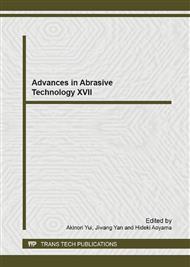p.520
p.526
p.532
p.539
p.544
p.549
p.553
p.559
p.565
Grinding Performance of Diamond Grinding Tools for Sapphire Crystal
Abstract:
In order to improve the efficiency and reduce the cost of sapphire crystal machined by loose abrasive lapping, the fixed-abrasive diamond grinding tools for sapphire grinding were investigated in this paper. Four vitrified-resin composite bond diamond grinding tools with different grain sizes (40μm, 20μm, 7μm, 2.5μm) were developed. The grinding experiments were performed with the developed diamond grinding tools and the grinding performance of four grinding tools were evaluated by comparing the surface roughness and the material removal rate (MRR) of sapphire. The experiment results show that with the increase in grain size, both the MRR and the surface roughness increase. A high-efficiency and high-quality ultra-precision grinding process using diamond grinding tools with different grain sizes was proposed.
Info:
Periodical:
Pages:
544-548
Citation:
Online since:
September 2014
Authors:
Price:
Сopyright:
© 2014 Trans Tech Publications Ltd. All Rights Reserved
Share:
Citation:


